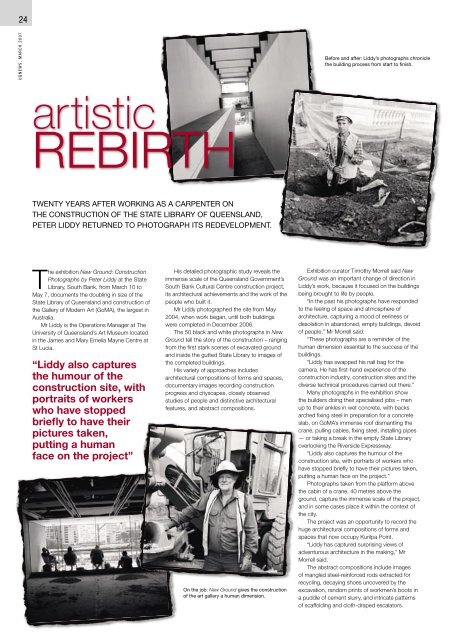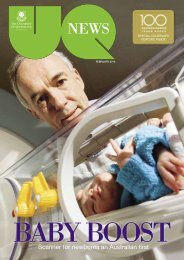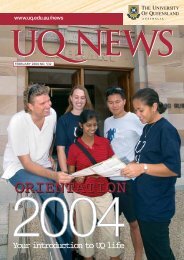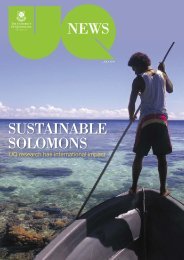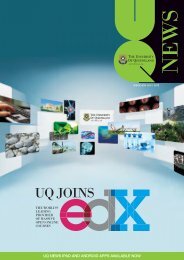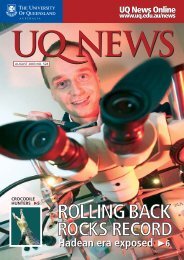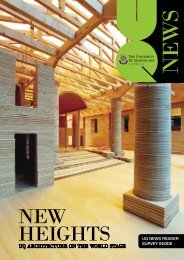Issue 562 (March 2007) - Office of Marketing and Communications
Issue 562 (March 2007) - Office of Marketing and Communications
Issue 562 (March 2007) - Office of Marketing and Communications
- No tags were found...
You also want an ePaper? Increase the reach of your titles
YUMPU automatically turns print PDFs into web optimized ePapers that Google loves.
24U Q N E W S , M A R C H 2 0 0 7Before <strong>and</strong> after: Liddy’s photographs chroniclethe building process from start to finish.artisticREBIRTHTWENTY YEARS AFTER WORKING AS A CARPENTER ONTHE CONSTRUCTION OF THE STATE LIBRARY OF QUEENSLAND,PETER LIDDY RETURNED TO PHOTOGRAPH ITS REDEVELOPMENT.The exhibition New Ground: ConstructionPhotographs by Peter Liddy at the StateLibrary, South Bank, from <strong>March</strong> 10 toMay 7, documents the doubling in size <strong>of</strong> theState Library <strong>of</strong> Queensl<strong>and</strong> <strong>and</strong> construction <strong>of</strong>the Gallery <strong>of</strong> Modern Art (GoMA), the largest inAustralia.Mr Liddy is the Operations Manager at TheUniversity <strong>of</strong> Queensl<strong>and</strong>’s Art Museum locatedin the James <strong>and</strong> Mary Emelia Mayne Centre atSt Lucia.“Liddy also capturesthe humour <strong>of</strong> theconstruction site, withportraits <strong>of</strong> workerswho have stoppedbriefly to have theirpictures taken,putting a humanface on the project”His detailed photographic study reveals theimmense scale <strong>of</strong> the Queensl<strong>and</strong> Government’sSouth Bank Cultural Centre construction project,its architectural achievements <strong>and</strong> the work <strong>of</strong> thepeople who built it.Mr Liddy photographed the site from May2004, when work began, until both buildingswere completed in December 2006.The 50 black <strong>and</strong> white photographs in NewGround tell the story <strong>of</strong> the construction – rangingfrom the first stark scenes <strong>of</strong> excavated ground<strong>and</strong> inside the gutted State Library to images <strong>of</strong>the completed buildings.His variety <strong>of</strong> approaches includesarchitectural compositions <strong>of</strong> forms <strong>and</strong> spaces,documentary images recording constructionprogress <strong>and</strong> cityscapes, closely observedstudies <strong>of</strong> people <strong>and</strong> distinctive architecturalfeatures, <strong>and</strong> abstract compositions.On the job: New Ground gives the construction<strong>of</strong> the art gallery a human dimension.Exhibition curator Timothy Morrell said NewGround was an important change <strong>of</strong> direction inLiddy’s work, because it focused on the buildingsbeing brought to life by people.“In the past his photographs have respondedto the feeling <strong>of</strong> space <strong>and</strong> atmosphere <strong>of</strong>architecture, capturing a mood <strong>of</strong> eeriness ordesolation in ab<strong>and</strong>oned, empty buildings, devoid<strong>of</strong> people,” Mr Morrell said.“These photographs are a reminder <strong>of</strong> thehuman dimension essential to the success <strong>of</strong> thebuildings.“Liddy has swapped his nail bag for thecamera. He has first-h<strong>and</strong> experience <strong>of</strong> theconstruction industry, construction sites <strong>and</strong> thediverse technical procedures carried out there.”Many photographs in the exhibition showthe builders doing their specialised jobs – menup to their ankles in wet concrete, with backsarched fixing steel in preparation for a concreteslab, on GoMA’s immense ro<strong>of</strong> dismantling thecrane, pulling cables, fixing steel, installing pipes— or taking a break in the empty State Libraryoverlooking the Riverside Expressway.“Liddy also captures the humour <strong>of</strong> theconstruction site, with portraits <strong>of</strong> workers whohave stopped briefly to have their pictures taken,putting a human face on the project.”Photographs taken from the platform abovethe cabin <strong>of</strong> a crane, 40 metres above theground, capture the immense scale <strong>of</strong> the project,<strong>and</strong> in some cases place it within the context <strong>of</strong>the city.The project was an opportunity to record thehuge architectural compositions <strong>of</strong> forms <strong>and</strong>spaces that now occupy Kurilpa Point.“Liddy has captured surprising views <strong>of</strong>adventurous architecture in the making,” MrMorrell said.The abstract compositions include images<strong>of</strong> mangled steel-reinforced rods extracted forrecycling, decaying shoes uncovered by theexcavation, r<strong>and</strong>om prints <strong>of</strong> workmen’s boots ina puddle <strong>of</strong> cement slurry, <strong>and</strong> intricate patterns<strong>of</strong> scaffolding <strong>and</strong> cloth-draped escalators.


